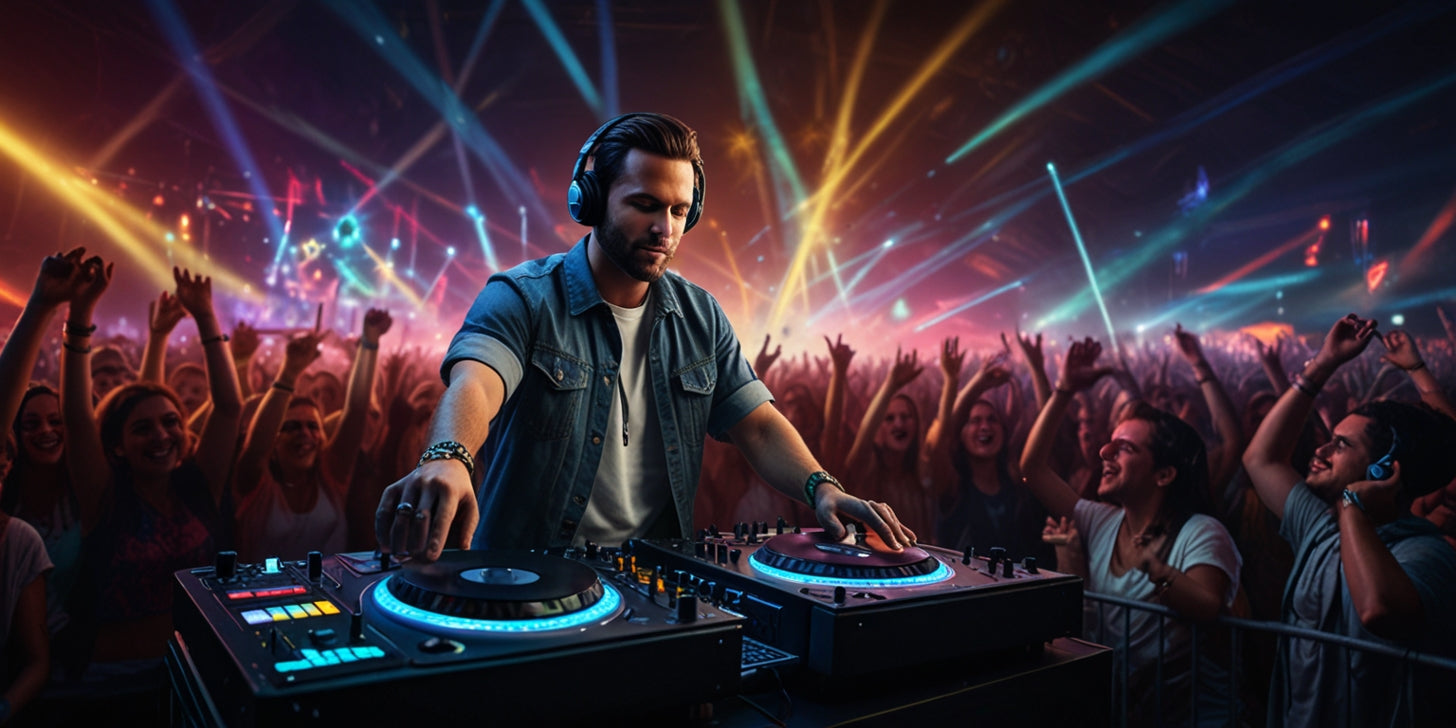A DJ, short for Disc Jockey, wears many hats—music curator, audio artist, and crowd controller, all rolled into one. While most people picture DJs surrounded by flashing lights and packed dancefloors, the heart of DJing hasn’t changed: it’s about selecting and manipulating recorded music to move a crowd.
Table of Contents
- What does DJ stand for and what does DJ mean?
- What do DJs do?
- Types of DJs
- What do DJs use?
- How to Become a DJ
- Essential Skills Every DJ Should Master
But these days, it’s not just about playing tracks. The art of DJing blends musical taste with performance, timing, and serious technical skill. The DJ career path can lead just about anywhere.
Some DJs start with small local gigs or wedding events, while others climb the ladder to perform at international music festivals, stream sets on online DJing platforms, or even entertain guests on cruise ships.
You’ll also find them hosting shows on radio stations or building a loyal online following. As music consumption shifts, so does the role of the DJ. Today, DJs don’t just play songs—they shape the energy of the atmosphere, they build a mood, and craft an immersive audio journey for their audience.
In a world overflowing with streaming playlists, the DJ remains unique—someone who understands music psychology, timing, and the energy of a crowd. Whether mixing vinyl records, digital files from a cloud-based music library, or producing live DJ sessions from a laptop, DJs stand at the intersection of performance art and technology.
What does DJ stand for and what does DJ mean?
DJ stands for Disc Jockey, this title was first used in the 1930s during the rise of radio. The early DJs would “jockey” records, and offer musical selections between commentary, ads, or interviews. Over the time, this role evolved beyond just radio and into the energetic nightlife and entertainment scene.
Origins of the Term
The real DJ culture is rooted withinin the block parties of the 1970s Bronx, with legends like DJ Kool Herc, who layed the foundation for hip-hop through rhythmic breaks and turntable basics. He would use two turntables and a mixer, and would extend instrumental sections of funk songs—a technique popularly known as “The Merry-Go-Round.”
Modern Usage Across Media Formats
Fast forward to today, and DJs work in a variety of media:
• Broadcast radio
• Club nights
• Online streaming
• Festivals
• Private events
• Cruise ships and resorts
• Virtual platforms like Twitch and Mixcloud
They also play key roles in audio and visual production, remixing tracks and shaping the sound of pop culture through collaborations with producers and artists.
Evolution from Vinyl to Digital
Vinyl used to be the DJ’s main medium, but today, music is often played via USB drives, laptops, or streaming integrations. Using digital files for DJing with software like Rekordbox or Serato, has made the art more accessible without diminishing the skill needed to excel.
Now you’ve got Digital tools like MIDI controllers, CDJs, and cloud syncing which have transformed performance capabilities and opened the doors to more creative possibilities.
What do DJs do?
At their core, DJs are entertainers, technicians, and curators. Their job is not just pressing play—they shape energy, set the tone, and directly impact how people feel on the dancefloor or while enjoying from home.
DJs have to manage the transitions between songs, maintain a tempo (BPM syncing), adjust the EQ settings, and often party directly with the crowd while facing them. They’re the ones that read the room, modify their setlists on the fly, and ensure that the music makes the audience fall in love.
Types of DJs
🎧 Club DJ
A Club DJ is perhaps the most recognized one, they perform in nightclubs or lounges where the energy and crowd interaction are key. These DJs specialize in beat-driven genres like house, techno, hip-hop, or EDM. Most of what they do includes track mixing, DJ mixing techniques, EQ blending, and set flow and transitions to keep the people moving their bodies.
Club DJs usually keep a deep music library, have excellent crowd engagement techniques, and an understanding of sound systems. They often use CDJs, mixing consoles, and effects to build immersive and immaculate sets that can last hours.
👰 Wedding DJ
A Wedding DJ wears many hats—DJ, emcee, and sometimes even an event coordinator. Their role includes managing the evening’s timeline, making announcements, and ensuring that guests remain entertained. They could switch between romantic ballads, party anthems, and cultural music, often guided by what the guests love.
They rely on an organized DJ event checklist, sing-along equipment, and a music library that caters to all ages. Wedding DJs must be adaptable, personable, and comfortable speaking into a mic.
📻 Radio DJ / On-Air DJ
A Radio DJ is somebody who programs broadcasting and audio production. Their job includes introducing songs, reading news, conducting interviews, and sharing commentary. This type of DJ would usually work in studios and follows a much more structured format than live performers.
They must know about broadcasting basics, voice modulation, and how to appeal to a very wide listening audience. With the rise of online DJing platforms, radio DJs have expanded to podcasts and livestreaming.
🎤 Karaoke DJ
Karaoke DJs (KJs) create fun, and interactive environments where guests can sing along to backing tracks. They handle the microphone inputs, manage lyrics displays, and maintain a a soft light-hearted atmosphere. These DJs need really effective crowd-reading skills and the ability to keep energy levels up, even between performances.
🎉 Event / Cruise Ship / Resort DJ
These DJs play in front of highly diverse audiences at large gatherings and vacation spots. Their job needs them to be versatile, and swiftly moving between genres like pop, Latin, reggae, or throwbacks depending on the what the location and vibe is. A cruise ship DJ, for example, might play family-friendly hits by day and high-energy dance music by night.
This role also demands a polished DJ persona, adaptability to venue-specific tech, and strong event networking skills.
What do DJs use?
DJ Gear Overview: Hardware
Modern DJs use a mix of hardware and software. Essential DJ gear includes:
• CDJs or XDJs: Advanced media players with jog wheels, pitch controls, looping functions, and waveform displays.
• Turntables: Still used for scratching and vinyl-based performances.
• DJ Controllers: All-in-one solutions with mixing consoles, FX units, and USB inputs—popular among beginners.
• Mixers: The central unit connecting all audio sources and allowing fine control over transitions, volume, and EQ.
• DJ Headphones: For cueing and pre-listening before live transitions.
Software & Digital Tools
DJs now rely heavily on powerful digital platforms for both performance and music library management:
• Rekordbox: Ideal for CDJ/XDJ users with playlist prep and BPM analysis.
• Serato DJ: Known for reliability in club settings and compatibility with many controllers.
• Virtual DJ: A versatile tool for hobbyists and professionals.
• Ableton Live: Used by performance-focused DJs and producers to build custom sets or hybrid live shows.
They often integrate cloud services like Dropbox, Beatport Link, or SoundCloud for remote access to music, DJ mix recording, and sharing. If you wanna know the exact type of DJ Equipment pieces you should use then check out our DJ Equipment guide for 2025.
How to Become a DJ
Starting your journey into DJing doesn’t require expensive equipment or years of training, but it does require dedication, curiosity, and consistent practice.
Step-by-Step:
1. Learn the Basics
Start with DJ tips for beginners: watch DJ tutorials, understand beatmatching, and practice on free software.
2. Get the Gear
Invest in beginner DJ equipment: a basic controller, laptop, and headphones. Use DJ gear guides to decide what suits your style and budget.
3. Training and Practice
Consider enrolling in DJ school training or taking online courses. Practice regularly by recording DJ sets and testing transitions.
4. Build Your Library
Curate a diverse music library with tracks across genres and energy levels. Focus on high-quality audio formats (WAV, AIFF, MP3).
5. Start Performing
Look for entry-level DJ jobs—house parties, open mic nights, livestreams. Every gig helps you develop your craft and confidence.
6. Network and Promote
Create a brand, design a logo, post on social media, and build an online following. Use platforms like SoundCloud or Mixcloud to share your sets.
7. Build Your Reputation
Reputation is everything. Be professional, show up prepared, and leave a positive impression. Leverage DJ event participation to grow your name.
Essential Skills Every DJ Should Master
Becoming a successful DJ involves a mix of technical mastery and performance confidence.
• Beatmatching: Manually aligning tempos of two tracks using pitch faders.
• Mixing using EQ: Smooth transitions by adjusting bass, mid, and treble frequencies.
• Track Selection Strategy: Knowing which song fits the moment is an art.
• Reading the Crowd: Adjusting your set based on audience energy.
• DJ Mix Creation Strategies: Planning transitions, energy levels, and “peak moments.”
• Controlling Volume Levels: Ensuring balance between tracks and avoiding distortion.
• DJ Psychology: Understanding emotional arcs, anticipation, and energy release.
• Body Language & Stage Presence: Projecting confidence through performance skills.
• Handling Equipment: Setting up, troubleshooting, and maintaining gear.
As you grow, your skillset will naturally expand to include music production, sampling, and even live hybrid performances with synths or instruments.
Final Thoughts
DJing as a career choice is both exciting and rewarding. Whether you're playing a wedding, spinning at a club, or broadcasting a radio show, the DJ holds the power to connect people through sound.
With the right gear, foundational skills, and a passion for music, anyone can learn to DJ and carve their own path. Stay curious, stay consistent—and keep the beats flowing.

